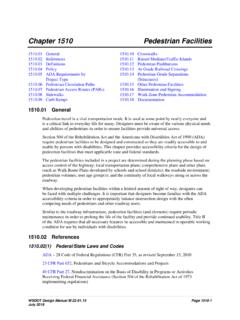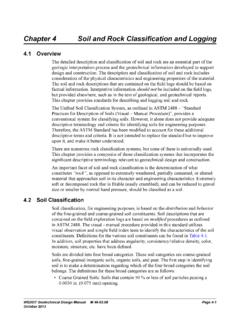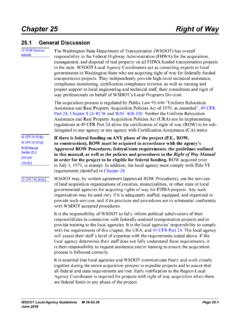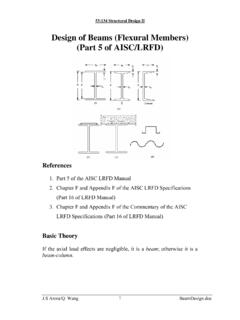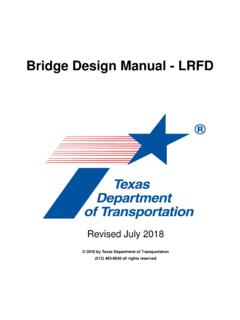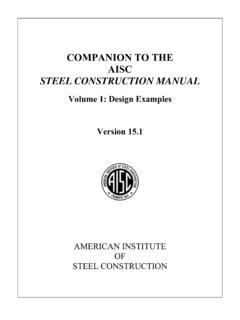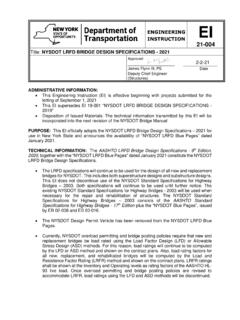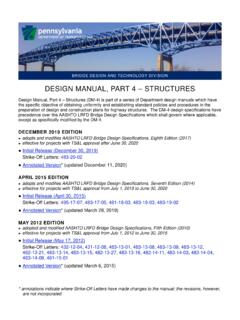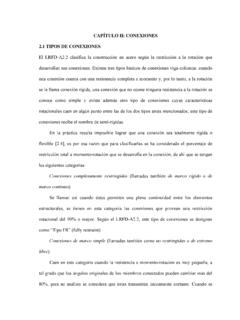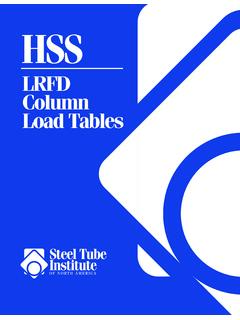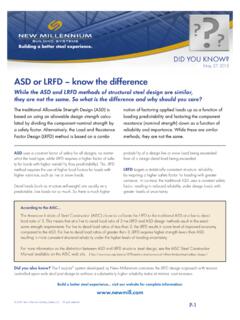Transcription of Chapter 9 Bearings and Expansion Joints Contents
1 WSDOT Bridge Design manual M Page 9-i September 2020 Chapter 9 Bearings and Expansion Joints Expansion Joints .. General Considerations .. General Design Criteria .. Small Movement Range Joints .. Medium Movement Range Joints .. Large Movement Range Joints .. Bearings .. General Considerations .. Force Considerations .. Movement Considerations .. Detailing Considerations .. bearing Types .. Miscellaneous Details .. Contract Drawing Representation .. Shop Drawing Review .. bearing Replacement Considerations .. Seismic Isolation Bearings .. General Considerations .. Suitability and Selection Considerations .. General Design Criteria .. Seismic Isolation bearing Submittal Requirements .. Seismic Isolation bearing Review Process .. Seismic Isolation bearing Inspection .. Bridge Standard Drawings .. Expansion Joints ..9-44 Chapter 9 Bearings and Expansion JointsPage 9-ii WSDOT Bridge Design manual M September 2020 WSDOT Bridge Design manual M Page 9-1 September 2020 Chapter 9 Bearings and Expansion Expansion General ConsiderationsAll bridges must accommodate, in some manner, environmentally and self-imposed phenomena that tend to make structures move in various ways.
2 These movements come from several primary sources: thermal variations, concrete shrinkage, creep effects from prestressing, and elastic post-tensioning shortening. With the exception of elastic post-tensioning shortening, which generally occurs before Expansion devices are installed, movements from these primary phenomena are explicitly calculated for Expansion joint selection and design. Other movement inducing phenomena include live loading (vertical and horizontal braking), wind, seismic events, and foundation settlement. Movements associated with these phenomena are generally either not calculated or not included in total movement calculations for purposes of determining Expansion joint movement respect to seismic movements, it is assumed that some Expansion joint damage may occur, that this damage is tolerable, and that it will be subsequently repaired. In cases where seismic isolation Bearings are used, the Expansion Joints must accommodate seismic movements in order to allow the isolation Bearings to function Joints must accommodate cyclic and long-term structure movements in such a way as to minimize imposition of secondary stresses in the structure.
3 Expansion joint devices must prevent water, salt, and debris infiltration to substructure elements below. Additionally, an Expansion joint device must provide a relatively smooth riding surface over a long service joint devices are highly susceptible to vehicular impact that results as a consequence of their inherent discontinuity. Additionally, Expansion Joints have often been relegated a lower level of importance by both designers and contractors. Many of the maintenance problems associated with in-service bridges relate to Expansion solution to potential maintenance problems associated with Expansion Joints is to use construction procedures that eliminate the Joints from the bridge deck. The two most commonly used methods are called integral and semi-integral construction. These two terms are sometimes collectively referred to as jointless bridge integral construction, concrete end diaphragms are cast monolithically with both the bridge deck and supporting pile substructure.
4 In order to minimize secondary stresses induced in the superstructure, steel piles are generally used in their weak axis orientation relative to the direction of bridge movement. In semi-integral construction, concrete end diaphragms are cast monolithically with the bridge deck. Supporting girders rest on elastomeric Bearings within an L-type abutment. Longer semi-integral bridges generally have reinforced concrete approach slabs at their ends. Approach slab anchors, in conjunction with a compression seal device, connect the monolithic end diaphragm to the approach slab. Longitudinal movements are accommodated by diaphragm movement Chapter 9 Bearings and Expansion JointsPage 9-2 WSDOT Bridge Design manual M September 2020relative to the approach slab, but at the same time resisted by soil passive pressure against the end , bridges cannot be built incrementally longer without eventually requiring Expansion joint devices.
5 The incidence of approach pavement distress problems increases markedly with increased movement that must be accommodated by the end diaphragm pressing against the backfill. Approach pavement distress includes pavement and backfill settlement and broken approach slab State Department of Transportation (WSDOT) has implemented jointless bridge design by using semi-integral construction. Office policy for concrete and steel bridge design is as follows:A. Concrete Bridges Semi-integral design is used for prestressed concrete girder bridges under 450 feet long and for post-tensioned spliced concrete girder and cast-in-place post-tensioned concrete box girder bridges under 400 feet long. Use L-type abutments with Expansion Joints at the bridge ends where bridge length exceeds these values. In situations where bridge skew angles exceed 30 degrees, consult the bearing and Expansion joint Specialist and the State Bridge Design Engineer for recommendations and Steel Bridges Use L-type abutments with Expansion Joints at the ends for multiple-span bridges.
6 Semi-integral construction may be used in lieu of Expansion Joints for single span bridges under 300 feet with the approval of the State Bridge Design Engineer. In situations where the bridge skew exceeds 30 degrees, consult the bearing and Expansion joint Specialist and the State Bridge Design Engineer for recommendations and all instances, the use of intermediate Expansion Joints should be avoided wherever possible. The following table provides guidance regarding maximum bridge superstructure length beyond which the use of either intermediate Expansion Joints or modular Expansion Joints at the ends is and Expansion Joints Chapter 9 WSDOT Bridge Design manual M Page 9-3 September 2020 Superstructure TypeMaximum Length (Western WA)Maximum Length (Eastern WA)Semi-IntegralL-AbutmentSemi-IntegralL -AbutmentConcrete SuperstructurePrestressed Girder*450 ft900 ft450 ft900 Spliced Girder**400 ft700 ft**400 ft700 ft** box girder400 ft700 ft **400 ft700 ft**Steel SuperstructurePlate Girder Box girder300 ft900 ft300 ft700 ft* Based upon 0.
7 16 in . creep shortening per 100 feet of superstructure length and 0 .12 inch shrinkage shortening per 100 feet of superstructure length** Based upon 0 .31 in . creep shortening per 100 feet of superstructure length and 0 .19 inch shrinkage shortening per 100 feet of superstructure length** Can be increased to 800 ft. if the joint opening at 64 F at time of construction is specified in the Expansion joint table to be less than the minimum installation width of 1 inches . This condition is acceptable if the gland is already installed when steel shapes are placed in the blockout . Otherwise (for example, staged construction) the gland would need to be installed at temperature less than 45 F . Because the movement restriction imposed by a bearing must be compatible with the movements allowed by the adjacent Expansion joint , Expansion Joints and Bearings must be designed interdependently and in conjunction with the anticipated behavior of the overall structure.
8 A plethora of manufactured devices exists to accommodate a wide range of Expansion joint total movements. Expansion Joints can be broadly classified into three categories based upon their total movement range as follows: Small Movement Joints Total Movement Range < 1 in. Medium Movement Joints 1 in. < Total Movement Range < 5 in. Large Movement Joints Total Movement Range > 5 General Design CriteriaExpansion Joints must be sized to accommodate the movements of several primary phenomena imposed upon the bridge following installation of its Expansion joint devices. Concrete shrinkage, thermal variation, and long-term creep are the three most common primary sources of movement. Calculation of the movements associated with each of these phenomena must include the effects of superstructure type, tributary length, fixity condition between superstructure and substructure, and pier Shrinkage Effects Accurate calculation of shrinkage as a function of time requires that average ambient humidity, volume-to-surface ratios, and curing methods be taken in consideration as summarized in AASHTO LRFD BDS Article Because Expansion joint devices are generally installed in their respective blockouts at least 30 to 60 days following concrete deck placement, they must accommodate only the shrinkage that occurs from that time onward.
9 For most situations, that shrinkage strain can be assumed to be for normal weight concrete in an unrestrained condition. This value must be corrected for restraint conditions imposed by various superstructure 9 Bearings and Expansion JointsPage 9-4 WSDOT Bridge Design manual M September 2020 Lshrink= Ltrib( )Where:Ltrib = Tributary length of the structure subject to shrinkage = Ultimate shrinkage strain after Expansion joint installation; estimated as in lieu of more refined calculations = Restraint factor accounting for the restraining effect imposed by superstructure elements installed before the concrete slab is cast = for steel girders, for precast prestressed concrete girders, for concrete box girders and T-beams, for concrete flat slabsB. Thermal Effects Bridges are subject to all modes of heat transfer: radiation, convection, and conduction.
10 Each mode affects the thermal gradients induced and deflection patterns generated in a bridge superstructure differently. Climatic influences vary geographically resulting in different seasonal and diurnal average temperature variations. Additionally, different types of construction have different thermal inertia properties. For example, a massive concrete box girder bridge will be much slower to respond to an imposed thermal stimulus than would a steel plate girder bridge composed of many relatively thin steel elements. Variation in the superstructure average temperature produces uniform elongation or shortening. Uniform thermal movement range is calculated using the maximum and minimum anticipated bridge superstructure average temperatures in accordance with AASHTO LRFD BDS Article Procedure A. For the purpose of establishing the maximum and minimum design temperatures using Procedure A, most of western Washington is classified as a moderate climate.





